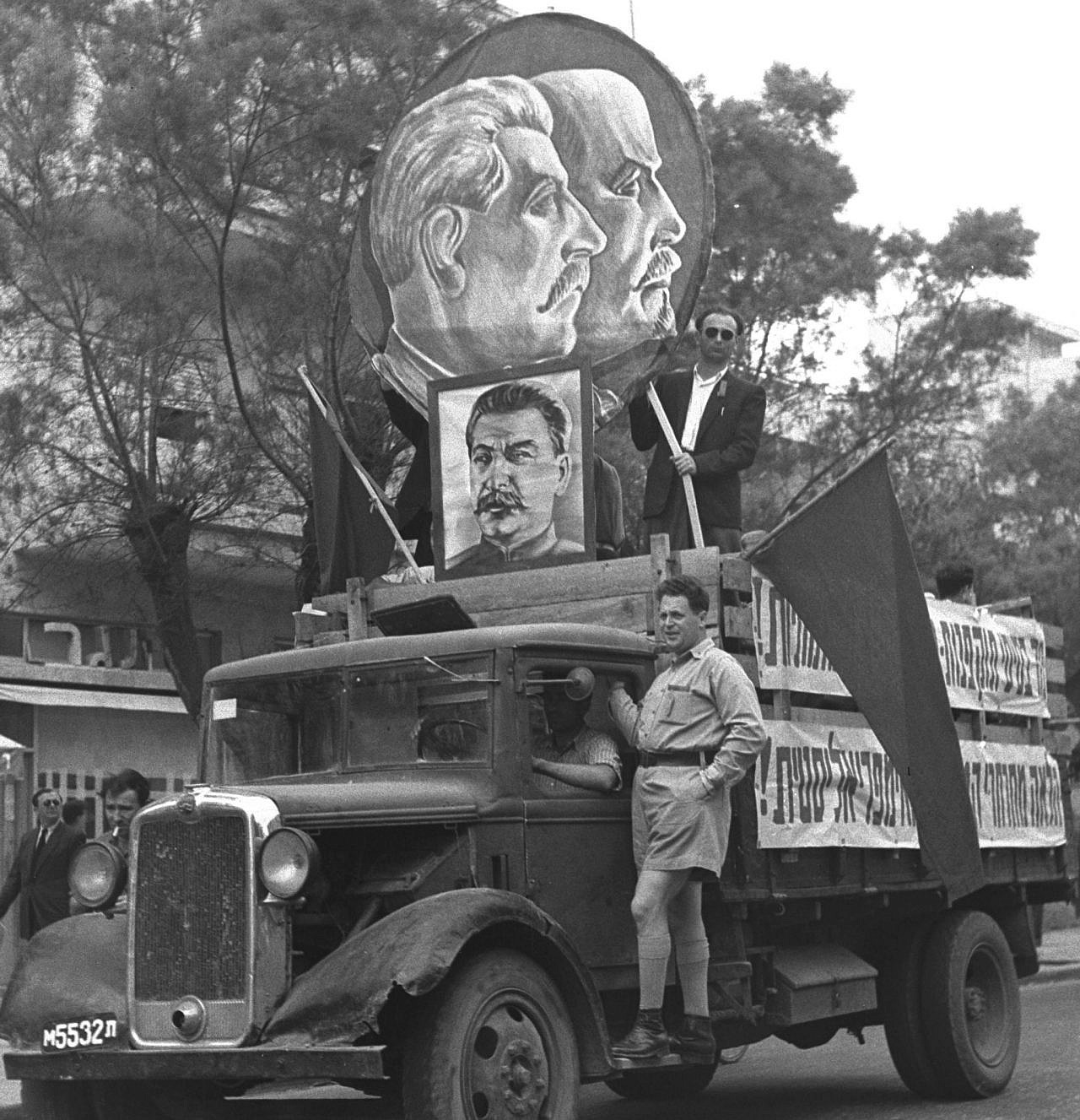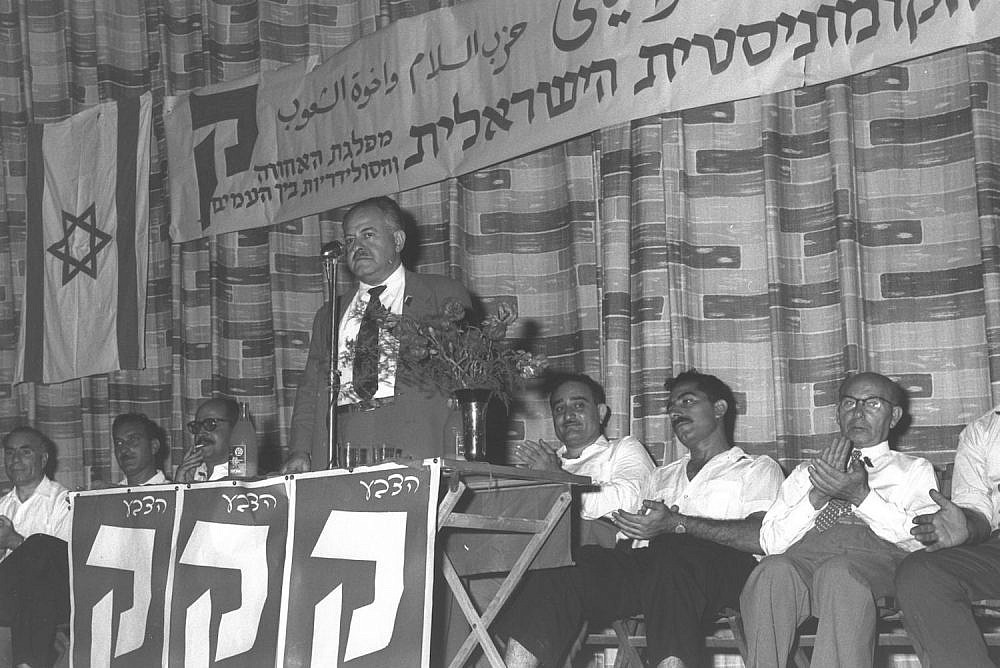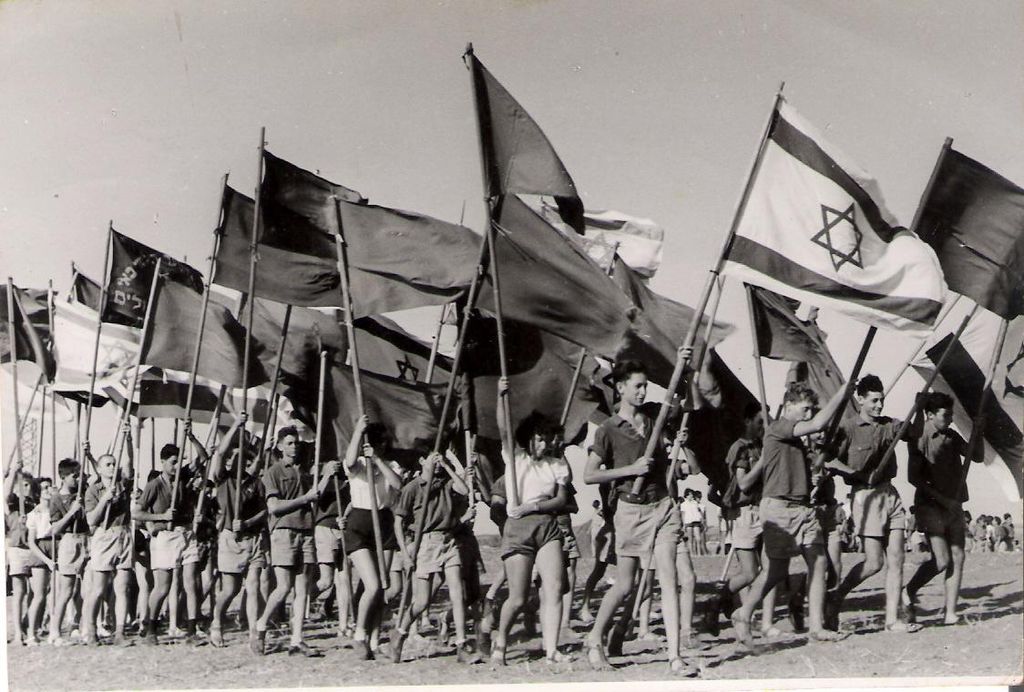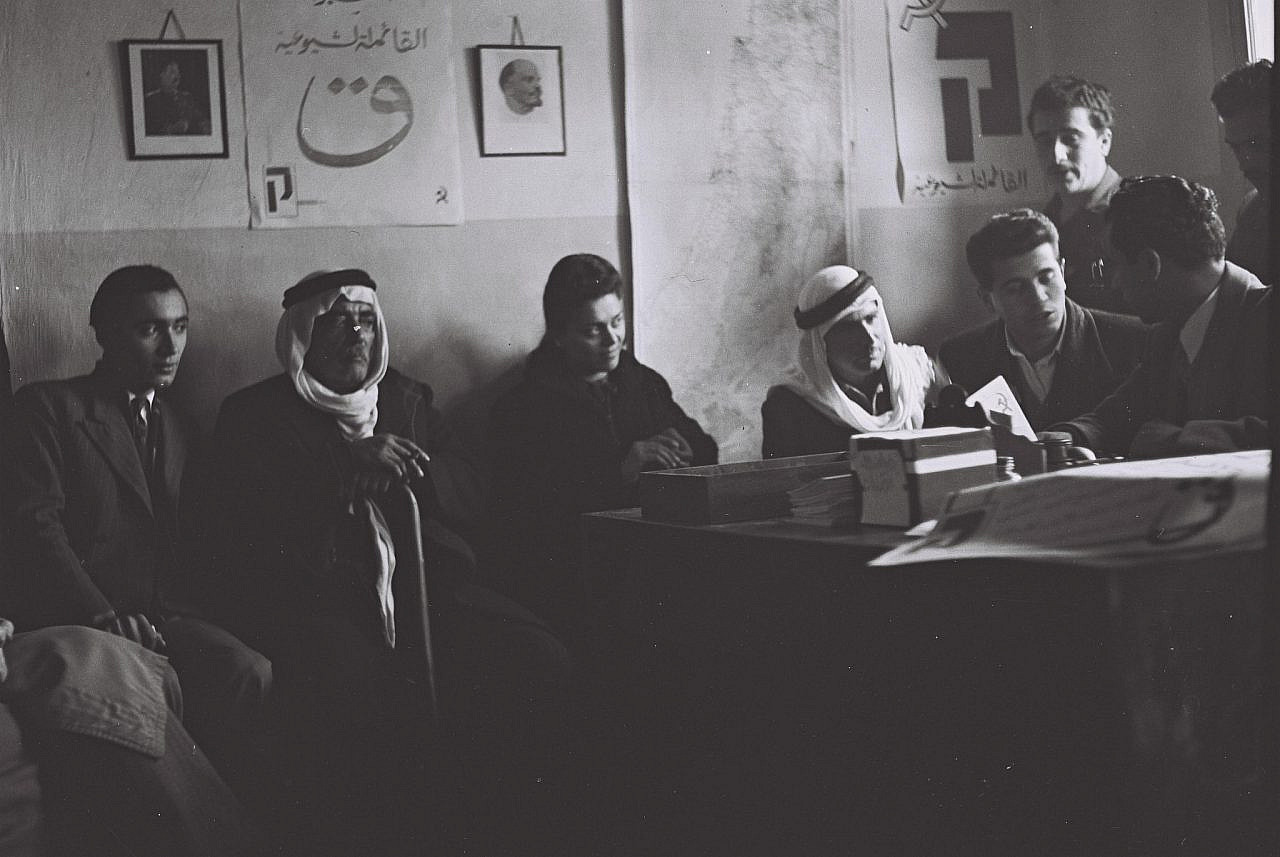“Holidays of the Revolution: Communist Identity in Israel, 1919-1945,” by Amir Locker-Biletzki, State University of New York Press, 2020.
When the story of Israel is told, certainly by Jews, it is almost always told from a Zionist perspective. For example, Arthur Hertzberg’s “The Zionist Idea” (first published in 1959) collects myriad examples of Zionist ideologues to illustrate the plethora of visions that existed within the Zionist movement. Anita Shapira’s comprehensive “Israel: A History” (2012) is likewise written fully within the Zionism paradigm.
The far left of that story are the Socialist Zionists, in part embodied by the Hashomer Hatzair and Habonim kibbutz movements and thinkers such as Ber Borochov or Nachman Syrkin, both architects of the Zionist labor movement. But there were other Jews in Palestine during those heady years who are often excluded from the story because they were decidedly anti-Zionist.
That’s right: Jews who lived in Palestine for the purpose of building a collective Jewish existence who were, nevertheless, anti-Zionist. I do not refer to Haredi anti-Zionists who thought Zionism was heresy, or the Canaanites who wanted to found a new Hebrew civilization divorced from Judaism and the Jewish diaspora. Both of these were marginal, more a curiosity than a real threat to the Zionist mainstream. I refer, rather, to Jewish Communists, internationalist revolutionaries with strong ties to Trotsky and the Comintern (the Third International Communist organization) who viewed Palestine as a location for Jews and Arabs to join forces in the global battle against capitalism and imperialism. (By Arabs here I refer only to Muslim and Christian Arabs, not Jews from Arab lands.)
Amir Locker-Biletzki’s excellent new study “Holidays of the Revolution: Communist Identity in Israel, 1919-1945” (SUNY Press, 2020) offers a fresh look at Jewish Communism in Palestine/Israel — not only from a political perspective, but from a cultural one as well. How did Jewish Communists confront, resist, and at times absorb their Socialist Zionist opponents? How did they construct a Jewish national identity against the Zionist one? How did they support Arab-Jewish solidarity while cultivating a Jewish nationalist (albeit anti-Zionist) program? And what can we learn from these Jewish Communists in today’s world where Zionism has arguably congealed into a chauvinist movement and, via the 2018 Jewish Nation-State Law, has codified its rejection of equality in Israel for all its citizens?
The post-Nation State Law, uber-capitalist Start-Up Nation is still mired in the highly ideological conundrum of its inception. An alternative to Zionism can still be gleaned from the (arguably archaic) communist battle against what the Jews who waged it saw as Zionism’s bourgeois and imperialist roots.
From ‘Jewish labor’ to Arab-Jewish solidarity
Locker-Biletzki writes, “At the core of the Jewish-Israeli Communist identity stood anti-Zionism. From its formative stages, Communists in Palestine-Israel preferred Socialism over Zionism.” This antagonism between seemingly adjacent ideological groupings is not unusual. The ultra-Orthodox anti-Zionists viewed the non-Zionist and religious Agudat Israel (founded in 1922), rather than secular Zionism, as their main opponents. They argued that Agudat Israel’s collusion with the Zionists sullied their own religious and ideological commitments. In a similar way, the Jewish Communists viewed the Socialist Zionists as their opponents, “subordinating their Marxism to their Zionism.” The Hashomer Hatzair movement often referred to their position as “Socialist realism,” which amounted to a merging of socialism and nationalism.
Locker-Biletzki shows the story was more complicated still. The Communists themselves “selectively used the cultural means and mechanisms created by the Socialist-Zionists in their own subculture.” The Communists in Palestine/Israel could not avoid the Zionist orbit in which they lived, even as they continued to try to find alternative ways of cultivating a national consciousness that remained wedded to the revolutionary project of class struggle and committed to the Jewish and Palestinian working class.
Hannah Arendt’s 1944 essay “Zionism Reconsidered” makes the point quite well. In her critique of the Socialist Zionists she writes:
Since the days of Borochov… the leftist Zionists never thought of developing their own answer to the national question: they simply added official Zionism to their socialism. The addition hasn’t made for an amalgam, since it claims socialism for domestic and nationalist Zionism for foreign affairs… no attention was paid to the economic conditions of the Arabs, who, through the introduction of Jewish capital and labor and the industrialization of the country, found themselves changed overnight into potential proletarians.
Arendt’s comment requires some nuance, in that “Jewish labor” was an attempt to diversify labor among Jews and create a Jewish proletariat in the land, which it did. Its point may not have been exclusively to reject Palestinian labor but also to create a diverse Jewish workforce and cultivate a sense of agency in building Jewish colonies and farms. In practice, however, it excluded the Arab majority in Palestine from the new Zionist project. Arendt writes: “The social revolutionary Jewish national movement, which started… with ideals so lofty that it overlooked the particular realities of the Near East and the general wickedness of the world, has ended, as do most such movement – with the unequivocal support not only of national but chauvinist claims – not against the foes of the Jewish people but against its possible friends and present neighbors.”
For the Socialists Zionists, as Arendt views them, the international reach of socialism became an internal project of Jewish revival. The Palestinians may have mattered, but they were not really part of the project. “Jewish labor,” the mark of the Second Aliyah, moved the Zionist movement from a regional project to a national one. Ironically, some scholars such as Rashid Khalidi in his book “Palestinian Identity,” argue that “Jewish labor” helped spark the rise of Arab nationalism in Palestine, drawing, for example, on the writings of the Palestinian Christian scholar Khali Sakakini. Edward Said noted in “The Question of Palestine” that “Jewish labor,” far from being only a noble exercise in self-sufficiency, was actually an exercise in exclusion. Socialist Zionists largely forsook solidarity that crossed ethnic lines.
While the Zionists were fortifying their national project, the Jewish Communists were struggling to develop a movement of Arab-Jewish solidarity and workers’ rights to create a socialist society founded on Jewish values that combined a commitment to revolution and equality. As Locker-Biletzki shows, their project was cultural as well as political. They developed rituals and ceremonies that combined the spirit of Communism with Judaism in a secularized form (many Zionists were also engaged in the secularization of Judaism). Politically they remained tied to the international Communist movement and its larger goals of labor rights and equality. As Communists, they were certainly anti-religious but so were the large majority of Zionists in this period.
With the introduction of Socialist Zionist figures such as Moshe Sneh and Shmuel Mikinus into the Communist Party — Mikinus in the 1940s and Sneh in the 1950s — the Communist Party slowly began to adopt quasi-Zionist ideas even as it continued to resist Zionism, renouncing it as an imperialist enterprise guilty of alienating and exploiting Arab workers. Sneh still opposed Zionism and was thus trying to thread the needle between what Locker-Biletzki calls, “the Israelization of parts of the Communist Party, not an account of the Zionization of the Communist Party.”
As I understand this, the Communist Party wanted to create Israeliness without Zionism, a collective identity that included both Jews and Palestinians. (Palestinians could and did live in a Zionist state as citizens but, as the Jewish Nation-State Law makes explicit, it is not their state. It is a “Jewish” state that they live in).
‘A Jewish internationalist class struggle staged from Palestine/Israel’
One of the more salient and useful aspects of Locker-Biletzki’s study is the story of how Jewish Communists were engaged in a project of forging an anti-Zionist Jewish national identity — as part of the larger communist commitment to class struggle that included at its core Arab-Jewish solidarity in Palestine, something they believed the Socialist Zionists had gradually abandoned for chauvinistic nationalism. Locker-Biletzki writes, “The heart of the Jewish Communist’s approach to Jewish nationalism lay not in the conflict between Zionism and Communism, between Jewish identity and Red assimilation, but the harmonization of Jewish and Israeli identities and internationalist and class approaches.”
As Nissim Calderon, a member of Banki, the Communist Party youth movement in 1962-1965 put it, “nationalism was welcome not as a negative phenomenon. We accepted it.” However, Zionism was not its appropriate form because it denied an internationalist component and it excluded non-Jews as part of its concern. The exclusively Jewish character of the Zionist project made it unfit as an ideology for a country with a sizable non-Jewish constituency (until 1947, the majority). It inevitably created Jewish hegemony and, by extension, inequality.
But even the Jewish Communists in America did not deny a new national identity in Palestine. Alexander Bittelman, a member of the Communist Party in the US who worked with Jews in the party in the 1940s, wrote that, “Communists can – and must – carry on the fight for national independence of their people, not as bourgeois nationalists but working-class internationalists.” (“Israel and the World Struggle for Peace and Democracy” 1948). The tide of history was too strong, however; national chauvinism won the day.
What was this non- or anti-Zionist Jewish identity the Communists wanted to create? It was not anti-statist per se: many Jewish Communists fought in the 1948 war. The identity, at its core, was “Jewish” but not exclusivist in terms of the state’s structure, and binationalist in principle. The Jewish Communists were committed to a Jewish internationalist class struggle staged from Palestine/Israel. Locker-Biletzki interestingly notes, “not unlike sections of Haredi society, [the communists] professed a limited loyalty to the state, defending its independence from imperialism while negating its Zionist ideological core.”
In both cases, one can be a Jewish collectivist of sorts, and not a Zionist. Thus Meir Vilner, the head of MAKI, the Israeli Communist Party in 1948, was a signatory to Israel’s Declaration of Independence and a long-standing Knesset member. Similarly, the non-Zionist Agudat Israel could agree to become part of the transgressive secular state.
The focus of Locker-Biletzki’s study is on the cultural aspects of the Jewish communist project, to show how Jewish Communists cultivated symbols, holidays, and rituals that merged the Jewish calendar with their internationalist communist agenda: the establishment of May Day parades in Tel Aviv where Jews and Arabs marched as one, the propagation of a communist interpretation of Hanukkah (opposing its hyper-nationalist Zionist formulation), and commemoration of the Holocaust that also includes the role of the Soviet Union in liberating concentration camps, most famously Auschwitz. The party celebrated independence by criticizing Israel’s dependence on western colonial powers, and viewed the new state as part of the global force of post-colonialism, called upon to be an exemplar of internationalism.

More emphatically, Holidays of the Revolution examines the complex ways Jewish Communists tried to cultivate a new Jewish national identity opposed to Zionism yet in favor of a Jewish national project. At the heart of this project was class struggle and Arab-Jewish solidarity. This may be where the study becomes more relevant for us today. The Jewish communist battle against Zionism’s bourgeois capitalist and imperialist underpinnings no longer resonates in the Start-Up Nation, three decades after the fall of the Soviet Union. But the question of Arab-Jewish solidarity remains.
‘The Jewish Communists became just another version of Zionists’
Echoing Arendt (and later Edward Said in his The Question of Palestine), Locker-Biletzki notes that “Socialist Zionists practiced the exclusion of Palestinians from the labor market and their lands marked out for Jewish settlement, culminating in the ethnic cleansing of the 1948 War and the military government that followed.” One could also recall David Ben-Gurion, a Socialist Zionist leader, who refused to allow Palestinians to return to their homes after the 1948 war at a time when it would not have significantly changed the demographic balance.
For many socialists, even as they began with much more idealistic hopes, socialism became an almost exclusively Jewish project, and some Jewish Communists were swept into that orbit as well, which in part resulted in the Arabization of the Communist Party in Palestine in the 1930s, as documented in Musa Budeiri’s “The Palestine Communist Party 1919-1948” (1979). Budeiri shows the way creeping statism begins to erode the solidarity of Jewish and Arab Communists as the yishuv moved further toward the establishment of a state, when “Yishuvism” morphed into eventual “Jewish” statism that the Communists opposed.
Jewish Communists persisted in Jewish-Arab solidarity, meanwhile, and this persistence resulted in a deep commitment to the Palestinian cause. “In stark contrast to Socialist-Zionist culture, which very quickly abandoned Socialist internationalist claims and developed a worker’s culture and institutions for Jews only, the Jewish Communists remained loyal to proletarian internationalism… In Marxist-Leninist terms, the Jewish Communists perceived Palestinians as the direct victims of Zionist colonization and British imperialism.”
Locker-Biletzki notes in his conclusion: “As the cultural transformation project of the Left Men [those integrating the Communist Party into the Zionist movement] gathered pace, the Communist internationalist and anti-Zionist parts of the Jewish communist identity eroded. At the end of this process, the Jewish Communists became just another version of Zionists, and then they were no more.” And yet, “Zionism is commonly perceived as the hegemonic form of Jewish nationalism in Palestine/Israel. This book has shown that beyond the Zionist hegemony and within Israeli environments a non-Zionist national identity – not based on pre-Zionist Judaism – can be formed… progressive and inclusive, in contrast to the exclusionary framing of Jewish-Israeli Zionist identity in Palestine/Israel ever since the late nineteenth century.”

Is the first part of his assertion correct? That is, has Jewish nationalism indeed become synonymous with Zionist hegemony? In many ways, yes, but we can also recall exceptions. Matzpen (Compass), for example, which was active in the 1960s and 1970s, presented an Israeli iteration of the American New Left. Its members – some of whom were exiles from MAKI and other socialist groups – forged a relationship with the newly-founded Israeli Black Panthers and set their sights on ending the occupation of the territories seized by Israel in 1967 as the most overt iteration of what they determined was Zionism’s chauvinistic underpinnings. The Arab-Jewish political party Hadash, of which MAKI is the most powerful faction and is now part of the Joint List, remains identified as non-Zionist today.
There are remnants of the Jewish Communists of old, a commitment to equality, economic justice and solidarity even if the international communist revolution no longer drives the narrative and even as Zionism, in its highly nationalized form, has become ubiquitous. True, this small remnant has almost no real voice in Israel. And yet they may hold a key to undoing the chauvinistic and hegemonic nature of the present state of Zionism that is illustrated in the Jewish Nation-State Law and the de-facto annexation of Palestinian territories.
Jewish nationality beyond ethnocentrism
What is the main challenge facing Zionism today? Zionism may have had its day and served its quintessential purpose — it certainly generated the founding of a Jewish state. But perhaps something new is required to bring that state into the twenty-first century. Maybe the Jewish Communist’s commitment to Arab-Jewish solidarity that was not heeded in a time when Jews were reeling from persecution and genocide, can once again become the raison d’etre of a new form of Jewish national identity that is not Zionist, but is founded on binationalism and shared sovereignty.
Jewish Communists (and others, like staunchly anti-Marxist Hannah Arendt) held this as well. Many believed by the 1930’s that Zionism could not overcome its chauvinistic and hyper-nationalist foundations. Arendt placed emphasis on the Atlantic City Resolution in 1944 that, in its statement, totally ignored the Palestinians (the 1942 Biltmore Platform does mention Arab minority rights even though Arabs were still the majority). Zionism, certainly its Herzlean variety, was at least in part instigated by antisemitism, but the European enemy eventually became the enemy in Palestine; the enemy where the Jews were the victims now became the enemy where the Jews are the sovereign.
Israel is now a country, albeit one that arguably carries on its back the weaknesses of Zionism that have become endemic to its identity. It remains locked in a nationalism that cannot quite make room for dual sovereignty and true solidarity with its Palestinian population. It has become an ethnocentric state. Arendt held that this was baked into the Zionist project even before statehood, while others like Martin Buber and Judah Magnes feared hyper-nationalism would take over the state’s agenda.
Locker-Biletzki provides us with a serious and well-crafted history of Jewish, and Arab and Jewish Communists in Israel who had another national vision, who were trying to forge a different project for Jewish national identity in Israel in the years before the state’s founding. Part of that project may no longer resonate in our neoliberal world of globalized capitalism. And the totalitarianism of Stalinism revealed in the 1950s alienated many Jewish Communists from the party. But other parts of the communist project in Israel can still resonate today: particularly the commitment to Arab-Jewish solidarity, justice, equality, and the protection of minorities. A vision that sees Jewish nationality outside of an ethnocentric framework in which one group is given privilege over another – otherwise known as a “Jewish state.”
It is easy to scoff and mock the Communist program as naïve and outdated. That may well be partially true. But we do so, in my view, at our own peril. As I see it, liberal and progressive Jews who care deeply about Israel are stuck, because the ideas upon which their liberalism and Zionism are founded are no longer relevant or cannot provide real solutions to the endemic problems of Zionism that the Communists, among others, saw in the 1920s. We can’t seem to think about non-Zionist Jewish national identity, but Zionism is stuck in a chauvinism of which it cannot seem to break free.
Maybe it is time to think of Jewish national identity beyond Zionism. The Jewish Communists, deeply committed to Jewish revival and equally committed to equality and justice, offered an anti-Zionist alternative. They are now almost inaudible. But they may have something crucial to offer after all.



